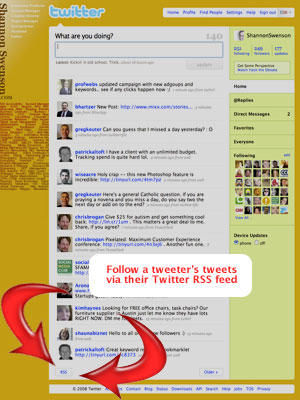Deconstructing Personal Twitter Feeds to Help Communication
Without being privy to formal Twitter usability studies, I’d wager most people rarely browse their tweet timeline beyond the first page. For those of us who follow hundreds and thousands of tweeters, we miss the vast majority of tweets in our network. It also means that only the most frequent tweeters have a chance of being heard by their followers.
How to hear your friends on Twitter
 When I’m in a consumer mode, I often click on individual tweeters to read their last series of posts. I gravitate toward different people depending on what mood/topic I’m interested in at the time.
When I’m in a consumer mode, I often click on individual tweeters to read their last series of posts. I gravitate toward different people depending on what mood/topic I’m interested in at the time.
My friend who is new to Twitter asks, “How can I push my friend’s tweets to me?” Easy. Scroll to the bottom of a profile and subscribe to the RSS feed. You will see their tweets in your reader.
You may have select tweeters of whom you’d like to read everything they say, so subscribe to their RSS feeds. Note, when someone deletes a tweet from their timeline, it still appears in their RSS feed like Google Reader or Facebook. People in this category might include:
- News feeds
- Family & close friends
- Thought leaders, trend watchers
- Twitter HR: Coworkers, staff, employees, applicants
- Prospective tenants
- Online reputation management
- Legal forensics
- Private accounts for project collaboration
- Companies, products, sports teams, celebrities
- Others? Leave a comment below!
How to be heard by your friends on Twitter
Use @name replies so tweets about them will show up in their Replies list. I’ve found people tend to favorite these tweets more often (I do too) and people are more apt to reply back. Be sure to put the @reply at the beginning of your tweet, otherwise it will not appear in their Replies list (Twitter should fix this).
I also direct message (DM) people with increasing frequency. By default, Twitter sends them an email to their preferred email account and it lands in their Direct Messages queue. Good uses for @replies and DMs are:
- Expressing appreciation for new follows
- Conventions, tweet-ups
- To make an introduction
- Apply for jobs w/ Twitter-savvy recruiters like @kimhaynes
- Ping a friend’s mobile device (also use the Nudge feature)
- Quick & pithy emails
- Top of mind awareness
- Lead generation
Is this helpful? Please talk back with a comment or tweet me with an @reply or DM 🙂
3 replies on “Reaching Friends In a Crowded Twitter Room”
Thank you – this is an excellent tip. I was wondering this and you provided the perfect info!
Twitter stepped in and took over the real-time information aspect of social media, something that even news websites had neglected to execute. The witnesses and participants of events were now ‘tweeting’ their experiences as they were occurring, feeding audiences with pure insight and uncensored content. Although Twitter feels like a lose end waiting to be tied, its remarkably exponential world-wide growth will sustain its community and – more importantly – create a connection among audiences that neither Facebook nor any other media can get close to reaching.
@Hummingbird – It’s amazing really when you consider how quickly the Twitter community can break news. Sitting in Austin, Texas, I was looking at a picture of Flight 1549 floating in the Hudson River just twenty minutes after it made an emergency water landing.
There is a legitimate concern of vetting real time information, something news bureaus traditionally handled. We have many examples of false rumors storming though social channels, but we also have examples of mainstream news misfiring while trying to scoop breaking news. Time is demonstrating that community policing is an effective check against social and mainstream news.
Here is an example of a news site performing well in social media. Our local paper, @statesman, does a great job of establishing separate Twitter feeds for breaking news on extremely short notice. As a news authority, they help corral real-time information simply by directing web & mobile traffic to a custom Twitter account. They generate custom hash tags so the topic trends on Twitter. Then they monitor the feeds for leads and post news updates as they are able to verify. They credit their Twitter sources and engage the community as the event unfolds. They’ve executed this strategy well with the Ft. Hood shootings and Joe Stack’s aerial attack on the IRS.